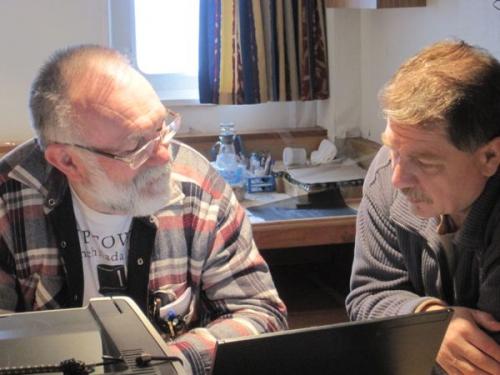When we woke this morning, we were heading north to reach the 1500 meter depth needed to put in a mooring and to do an otter trawl in the deeper water. Unfortunately, the ship can't travel as fast when surrounded by ice floes, and they also had to change direction at times to move around the heavier ice. When the decision was made to go north, we were 210 mile away, and 24 hours later, we were 220 miles away. As a result, chief scientist Terry Whitledge made the decision to turn around. We left our area of calm water, blue skies and polar bears to head south.
Terry Whitledge, chief scientist for both legs of the '04 and `09 cruises and our current Leg 2 of the 2012 RUSALCA cruise, is a chemical/biological oceanographer currently working as the Director of the Institute for Marine Science at the University of Alaska, Fairbanks. In addition to his work at the University of Alaska, Terry is the Principal Investigator on a project to build a new NSF ship, Sikuliaq (siku=sea ice and liaq=the modifier which makes it = new sea ice that's safe to walk on) to be operated by the University. Prior to boarding the ship in Nome, we had a chance to hear Terry's presentation about progress on the ship; he's obviously extremely proud of it as the design process included input from numerous Arctic scientists. He´s excited about the RUSALCA program, as it's the only US program with access to both US and Russian waters at the same time.
As Chief Scientist, it´s Terry´s job to try to meet the goals of each of the individual science teams on board. Most of the current projects are a continuation of work from the ´04 and '09 cruises which makes things a bit easier, but it´s still a balancing act to work with 47 scientists amidst changing weather, sea, and ice conditions as well as limited time. Leg 2 of the 2012 RUSALCA mission is several days shorter than the same leg in '09. Terry spends considerable time on the bridge, as he is also a conduit to the ship´s captain and crew.
In addition to his role as Chief Scientist, Terry is also doing hydrography and biological oceanography work on the cruise. He´s analyzing nutrients in the seawater and collaborating with the primary production group. For more, see the "Stormy Weather" journal. Terry´s work also supports the egg production work of the zooplankton group as well as the work of the water column and benthos teams. Additionally, his work ties in with the fish work being done on board since the primary production feeds the upper trophic levels (organisms that feed higher up in the food chain). This area has been closed off for commercial fishing until they can find out what resources are here.
As the ice cover changes in the Arctic. It´s important to understand the effects of nutrients and light on primary production. Based on early work done in the 1960´s, scientists assumed that ice cover limited production. However, as equipment and procedures have improved, scientists realized that there are no easy answers, and there are numerous variables to consider. For example, with increasing temperature and light, melting ice adds nutrient poor fresh water in addition to increased river run off which also adds water low in nutrients. Thus, less ice cover, not more, could actually limit production. Interestingly, while scientists believed for years that the 1% light level was the limit for phytoplankton growth, they now know that even less light (as little as .1%) can support production.
In addition to his work on this cruise, Terry had nutrient sensors on moorings from the first leg of this cruise as well as several others situated in the Bering Sea. He's actually had nutrient sensors on moorings since 2004 and he now has a good idea of the annual cycle of nitrate concentrations in the Bering Sea. It´s extremely important to get data from several stations in order to see if there are general trends over a large area or if there have been any changes over time.
Note: During the day yesterday, our marine mammal observer spotted another polar bear. Once again, everyone stopped what he or she had been doing and rushed to the bow or the bridge to get a better view. This bear was on an ice floe fairly close by, and it was busy eating the remains of a seal it had taken. Because it was reluctant to leave, everyone got good pictures as the boat drifted closer. Finally, with a portion of the seal still remaining, the bear decided to slip into the water. Those who watched as we moved by the bear said they thought they could see it returning to finish its meal.



Comments